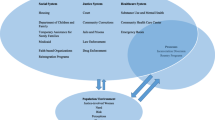Abstract
This review of 12 studies examines both the types of community and professional services that abused women most frequently contact, and how useful and effective the women perceive those services to be. These studies show that police, social service agencies, clergy, crisis lines, physicians, psychotherapists, women's groups, and lawyers are the sources of assistance abused women most frequently contact. However, the studies reveal that some of these services are not necessarily perceived as very useful or effective. Women tend to contact different services depending on the type of abuse suffered. Abused women report that crisis lines, women's groups, social workers, psychotherapists, and physicians are helpful most of the time for all types of abuse, and that police officers, lawyers, and clergy are not helpful in most types of abuse. Results of this review suggest the need for education of professionals and community service providers in understanding needs of abused women.
Similar content being viewed by others
References
Bowker, L. H. (1983).Beating Wife Beating. Health, Lexington, MA.
Bowker, L. H. (1988). The effect of methodology on subjective estimates of the differential effectiveness of personal strategies and help sources used by battered women. In Hataling, G. T., Finkelhor, D., Kirkpatrick, J. T., Straus, M. A. (eds.),Coping with Family Violence: Research and Policy Perspectives, Sage, California, pp. 80–92.
Bowker, L. H., and Maurer, L. (1986). The effectiveness of counseling services utilized by battered women.Women Ther. 5: 65–82.
Dobash, R. E., and Dobash, R. P. (1987). Violence towards wives. In Orford, J. (ed.),Treating the Disorder, Treating the Family, Johns Hopkins University Press, Baltimore, pp. 169–193.
Dobash, R. E., and Dobash, R. P. (1992).Women, Violence and Social Change. Routledge, London.
Donato, K. M., and Bowker, L. H. (1984). Understanding the helpseeking behavior of battered women: A comparison of traditional service agencies and women's groups.Int. J. Wom. Studies 7: 99–109.
Finkelhor, D., and Yllo, K. (1985).License To Rape: Sexual Abuse of Wives, Holt, Rinehart & Winston, New York.
Follingstad, D. R., Brennan, A. F., Hause, E. E., Polek, D. S., and Rutledge, L. L. (1991). Factors moderating physical and psychological symptoms of battered women.J. Fam. Viol. 6: 81–95.
Frieze, I., Knoble, J., Washburn, C., and Zomnir, G. (1980).Characteristics of Battered Women and Their Marriages, Final report of NIMH grant #RO1 MH 30913, University of Pittsburgh Press, Pittsburgh.
Gamache, D. J., Edleson, J. L., and Schock, M. D. (1988). Coordinated police, judicial, and social service response to woman battering: A multiple-baseline evaluation across three communities. In Hotaling, G. T., Finkelhor, D., Kirkpatrick, J. T., Straus, M. A. (eds.),Coping with Family Violence: Research and Policy Perspectives, Sage, California, pp. 193–209.
Gelles, R. J. (1987).Family Violence, Sage, California.
Gelles, R. J., and Straus, M. A. (1989).Intimate Violence, Touchstone, New York.
Hamilton, B., and Coates, J. (1993). Perceived helpfulness and use of professional services by abused women.J. Fam. Viol. 8: 313–324.
Horton, A. L., Wilkins, M. M., and Wright, W. (1988). Women who ended abuse: What religious leaders and religion did for these victims. In Horton, A. L., and Williamson, J. A. (eds.),Abuse and Religion, Lexington, MA, Lexington Books, pp. 235–245.
Kantor, G. K., and Straus, M. A. (1990). Response of victims and the police to assaults on wives. In Straus, M. A., and Gelles, R. J. (eds.),Physical Violence in American Families, Transaction Publishers, New Brunswick, pp. 473–488.
Margolin, G. (1988). Interpersonal and intrapersonal factors associated with marital violence. In Hotaling, G. T., Finkelhor, D., Kirkpatrick, J. T., and Straus, M. A. (eds.),Family Abuse and Its Consequences: New Directions for Research, Sage, Newbury Park, CA, pp. 203–217.
McEvoy, A., Brookings, J. B., and Brown, C. E. (1983). Responses to battered women: Problems and strategies.Social Casework J. Contemp. Social Work February, 92–96.
Murty, K. S., and Roebuck, J. B. (1992). An analysis of crisis calls by battered women in the city of Atlanta. In Viano, E. C. (ed.),Intimate Violence: Interdisciplinary Perspectives, Washington, DC, Hemisphere Publishing Corporation, pp. 61–70.
Pagelow, M. D. (1981).Women Battering: Victims and Their Experiences, Sage, Beverly Hills, CA.
Rodenburg, F. A. and Fantuzzo, J. W. (1993). The measure of wife abuse: Steps toward the development of a comprehensive assessment technique.Journal of Family Violence 8: 203–228.
Schulman, M. (1979).A Survey of Spousal Violence Against Women in Kentucky, Government Printing Office, Washington DC.
Sedlak, A. J. (1988). The use and psychosocial impact of a battered women's shelter. In Hotaling, G. T., Finkelhor, D., Kirkpatrick, J. T., Straus, M. A. (eds.),Coping with Family Violence: Research and Policy Perspectives California, Sage, pp. 122–128.
Sirles, E. A., Lipchik, E., and Kowalski, K. (1993). A consumer's perspective on domestic violence interventions.J. Fam. Viol. 8: 267–276.
Straus, M. A. (1990). The national family violence surveys. In Straus, M. A. and Gelles, R. J. (eds.),Physical Violence in American Families, Transaction Publishers, New Brunswick, pp. 3–116.
Straus, M. A., and Gelles, R. J. (1990). How violent are American families? Estimates from the national family violence resurvey and other studies. In Straus, M. A. and Gelles, R. J. (eds.),Physical Violence in American Families, Transaction Publishers, New Brunswick, pp. 95–112.
Strube, M. J. (1988). The decision to leave an abusive relationship: Empirical evidence and theoretical issues.Psychol. Bull. 104: 236–250.
Trimpey, M. L. (1989). Self-esteem and anxiety: Key issues in an abused women's support group.Issues Ment. Health Nurs. 10: 297–308.
Tutty, L. M., Bidgood, B. A., and Rothery, M. A. (1993). Support groups for battered women: Research on their efficacy.J. Fam. Viol. 8: 325–343.
United States Department of Health and Human Services (1991). Report of the Surgeon General of the United States.
Walker, L. (1979).The Battered Woman, Harper and Row, New York.
Author information
Authors and Affiliations
Rights and permissions
About this article
Cite this article
Gordon, J.S. Community services for abused women: A review of perceived usefulness and efficacy. J Fam Viol 11, 315–329 (1996). https://doi.org/10.1007/BF02333420
Issue Date:
DOI: https://doi.org/10.1007/BF02333420



